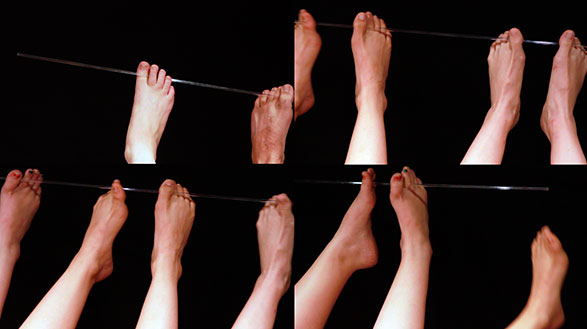

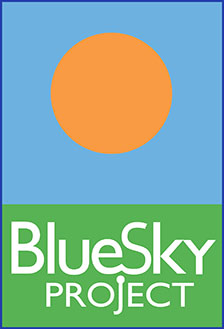
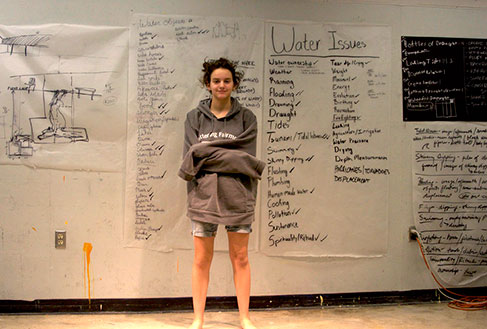
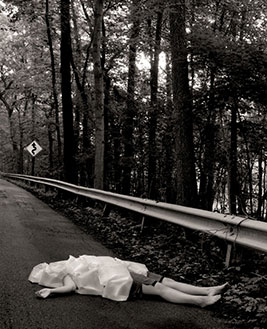
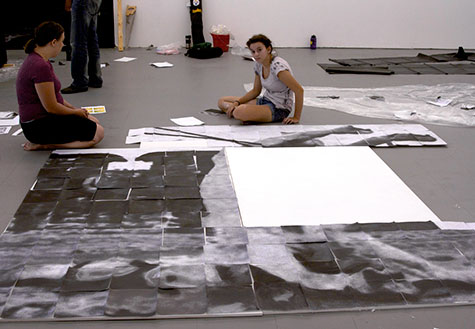
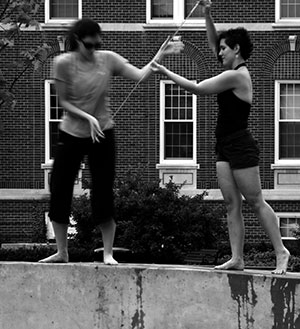
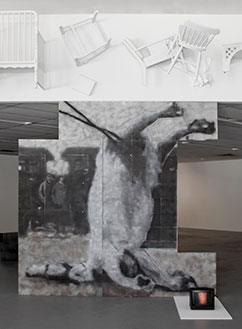
BLUE SKY PROJECT
Blue Sky Project is an artist-centered program committed to producing significant works of contemporary art by: providing a communal environment for the Resident Artists to extend their own exploration and studio practice in a unique collaborative setting with young people, using the contemporary art-making process to develop self-awareness, leadership, critical-thinking, creative problem solving and conceptual skills in the Youth Participants, and contributing to the cultural life of the community by bringing new art and new artists to Dayton. Blue Sky Project was originally founded in 2005 in McHenry County, Illinois by community activist Peter Benkendorf and contemporary artist Mequitta Ahuja. The goal of the program was to create a summer experience that empowered professional artists from around the world and area teens to collaborate and build community through the creation of ambitious works of contemporary art and performance. In 2009, Blue Sky Project moved to Dayton, Ohio where the program partnered with the University of Dayton and continued to host artists with a commitment to innovation.
McCue participated in the program as an artist-in-residence in 2011 and again in 2012 with his own take on the collaborative experience (see below). As one of five Blue Sky Project Artists-In-Residence, McCue cross-pollinated with other practicing artists, collaborated with teens, expanded his ideas and added artistic breadth and depth to the Dayton community. The basic premise of the program is to provide the artists-in-residence with the time and space to create their own work in intense collaboration with a small group of participating teens. Provided with a place to live, a budget, a studio assistant, and a space within which to work, McCue worked with a group of six teens in the creation of several new works. During the course of the eight-week residency, he had an enormous opportunity to relate his own creative ideas to ideas derived from the community and explore, experiment, and interpret within the contemporary works of art created. The culmination of the program was a final exhibition within the City of Dayton.


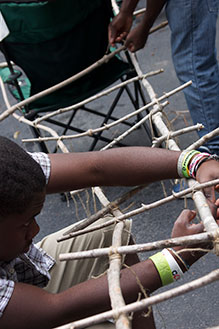
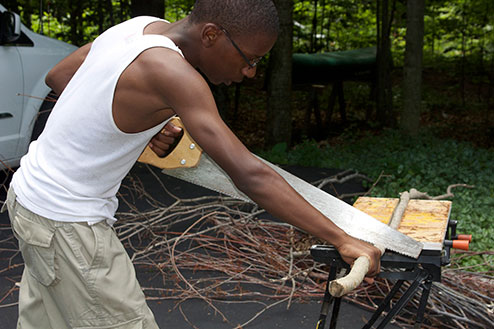
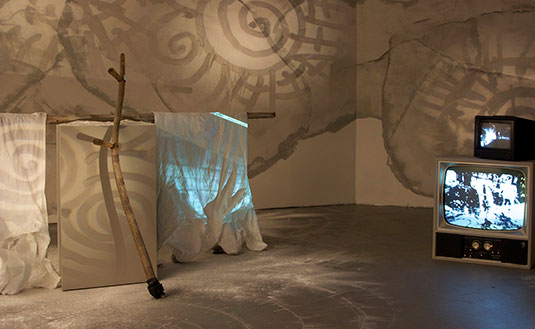

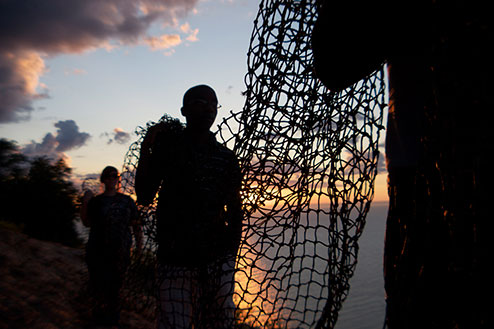
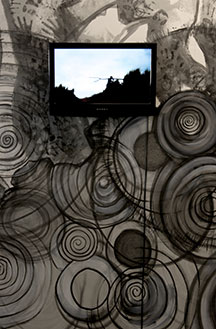
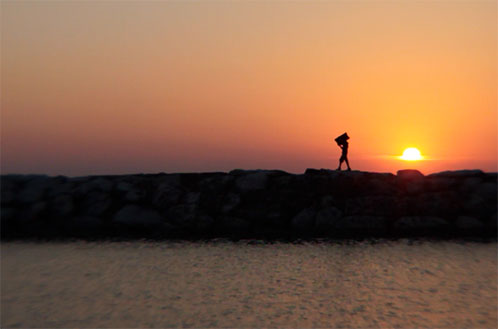

STICKS AND STONES: A BLUE SKY PROJECT COLLABORATION
This collaborative project was designed as a celebration of the Blue Sky Project and the creative work of Pamela Ayres and Kaz McCue. The focus of this project was a creative “exchange” which pushed the collaboration of the artists and youth involved outside of the walls of the studio and into a direct interaction with the environment. In its entirety, the project served to provide an opportunity for Blue Sky Project youth participants from past years an opportunity to go to a rustic setting and to explore and experience an environment very different from the urban environment of Dayton. Then, to provide a contrasting experience when the collaboration returned to Dayton, providing the young people with a unique experience. The project also provided a unique collaborative creative experience for Ayres and McCue as well as fostering expanded partnerships for Blue Sky Project.
The title “Sticks and Stones” refers to the two proposed environments within which the collaboration will take place. The idea of “sticks” relates directly to the woods of northern lower Michigan and “stones” refers to the city of Dayton, Ohio. Since the Blue Sky Project currently takes place in Dayton, the idea is to give the collaborators a chance to experience an environment that is vastly different from the one with which they are most familiar. The first phase of the exchange involved bringing a group of youth participants from past years to the Sleeping Bear Dunes area of Michigan for one week to work with Kaz McCue. Through their creative research about the area, the group developed the theme of migration and displacement and delved deep into these subjects as a reflection of their experiences. During that time, the group experienced the area and developed a collaboration that took place at Michigan Legacy Art Park in Thompsonville, Michigan. This environmental immersion gave the group a chance to really feel the natural environment in an effort to stimulate the creative interaction and collaboration. The second phase of the exchange took place in Dayton, Ohio for one week to work with Pamela Ayres. Again, the purpose is to immerse the group in the environment of this urban setting in order to inspire and inform the group’s work together. While in Michigan, McCue acted as the research lead for the youth participants while the kids served as a resource for Ayres in Dayton.
During the course of this project, there were two opportunities for presentation. The first took place at Michigan Legacy Art Park in the form of a site-specific installation. While in northern Michigan, the group also created a series of videos and artifacts that could be taken back to Dayton. The second presentation involved a series of installations, created in collaboration between the two artists and inspired by the work the two did with the youth participants in each location.
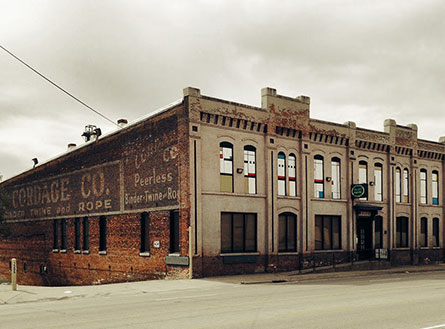
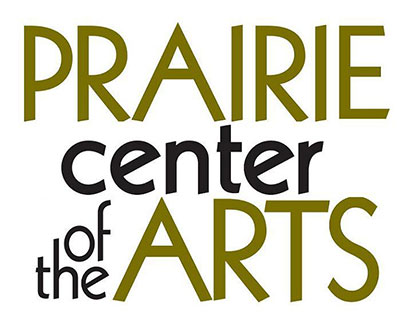
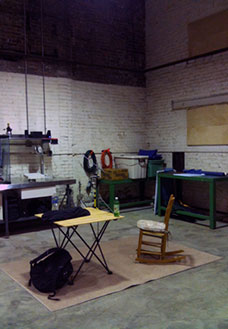

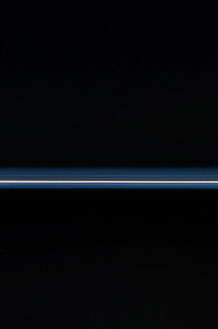
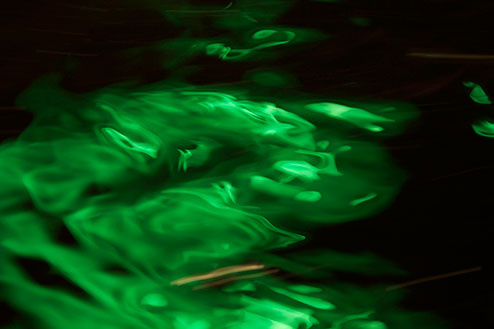
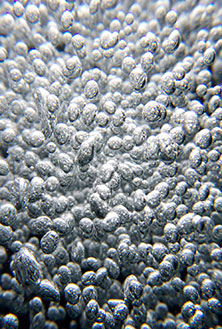
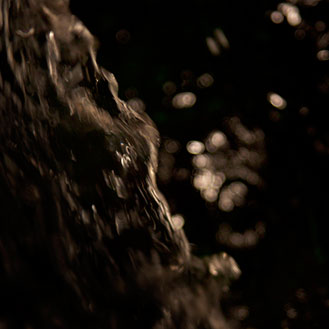
Water is sometimes sharp and sometimes strong, sometimes acid and sometimes bitter, sometimes sweet and sometimes thick or thin, sometimes it is seen bringing hurt or pestilence, sometime health-giving, sometimes poisonous. It suffers change into as many natures as are the different places through which it passes. And as the mirror changes with the colour of its subject, so it alters with the nature of the place, becoming noisome, laxative, astringent, sulfurous, salty, incarnadined, mournful, raging, angry, red, yellow, green, black, blue, greasy, fat or slim. Sometimes it starts a conflagration, sometimes it extinguishes one; is warm and is cold, carries away or sets down, hollows out or builds up, tears or establishes, fills or empties, raises itself or burrows down, speeds or is still; is the cause at times of life or death, or increase or privation, nourishes at times and at others does the contrary; at times has a tang, at times is without savor, sometimes submerging the valleys with great floods. In time and with water, everything changes. * from H2O – The Mystery, Art, and Science of Water (http://witcombe.sbc.edu/water/artleonardo.html) |
TAKING TO WATER: A PHOTOGRAPHIC PROJECT Water is the most abundant compound on earth and can be seen as a liquid, a solid or a gas. Throughout time, humans have had an intense attraction to and relationship with water. Water is an important component of our physical existence but it also represents much more than simple sustenance. Water lives in psychological, emotional, spiritual, and intellectual aspects of our lives as well. As I have explored my own relationship with water in visual terms, I also have realized how deeply connected my life is to water. When I was young, my family spent summers at the ocean and I used to play in the creek that flowed through our property. My zodiac sign is cancer, a water sign. I vividly remember the physics lab exercises that dealt with wavelengths by creating ripples in water. Water can be incredibly soothing and comforting but it can also be terribly destructive. While all of these factors are important it is the dynamics of water to which I am really becoming attracted. I began to see a direct correlation between the water I was using as a subject and the technology I was using to capture it. With a camera, you can record a duration of time in a single frame or stop the action with a fast shutter speed. As the camera exaggerates any sense of time and action, water can also vary its visual presence based on its flow or stagnation. It is the diversity of this dynamic in which I am most interested. In the course of pursuing the landscape as a photographic subject, I became more and more entranced by water and what it was capable of doing visually. After a while, the landscape disappeared and only the water was left. The images you see presented here were created during a three-month residency at the Prairie Center of the Arts in Peoria, Illinois. My goal for this residency was to take what I knew about water, light, and photography into the studio in order to create a controlled environment where I could manipulate all three of the elements in the creation of abstract images. To me, these photographs are more like paintings and drawings and speak to an emotional landscape where water is not only the subject but also the tool for creating images. |
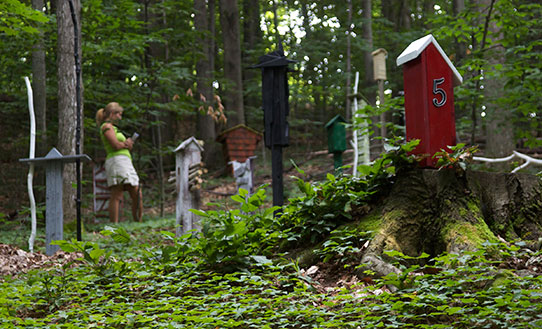

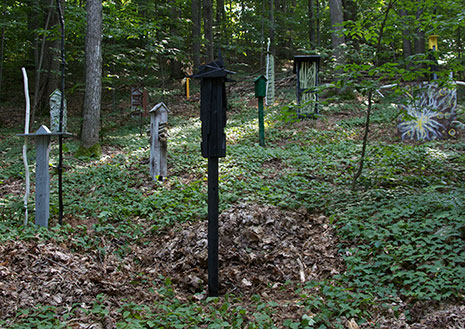
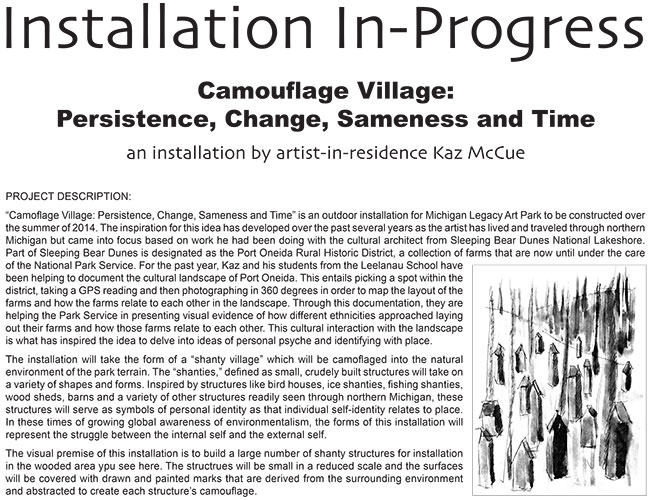

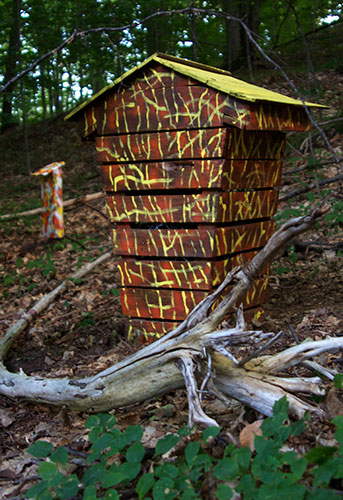
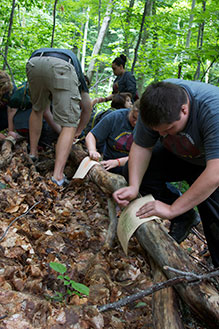
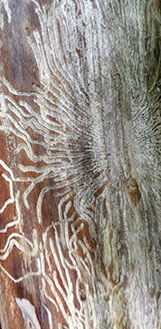
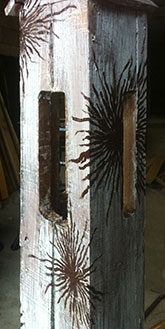
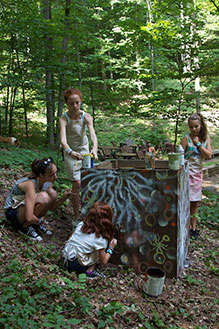
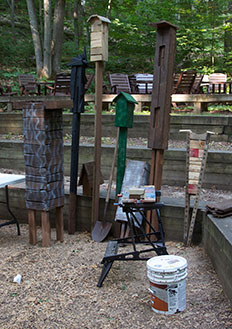
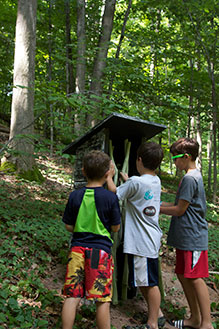
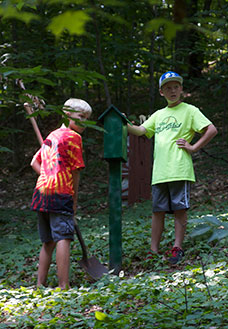
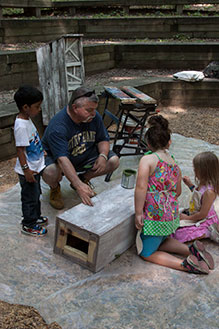
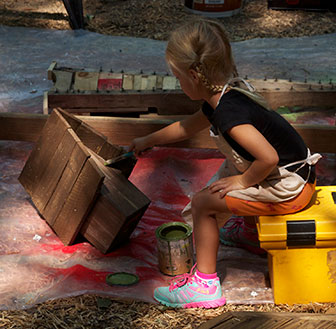

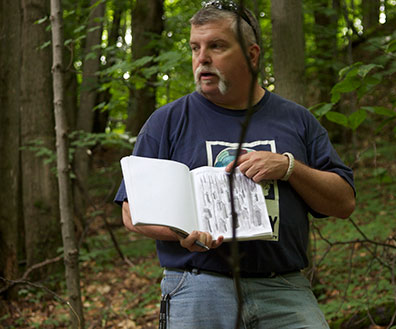
|
CAMOUFLAGE VILLAGE: PERSISTENCE, CHANGE, SAMENESS AND TIME “Camouflage Village: Persistence, Change, Sameness and Time,” was an artist-in-residence project that took place at Michigan Legacy Art Park in the summer of 2014. The project was designed as a community collaboration, creating a “hands-on” experience in the cumulative process of building an outdoor installation. During his six weeks of residency, McCue maintained an “outdoor studio” on site in the sculpture park where the public was invited to come and participate in the creation of a series of shanty-type structures. Each week the installation continued to grow and change based on the input and work of the participants. The eventual installation, which stayed on display in the art park for two years, took the form of a “shanty village” which was installed on a hillside off of one of the art park’s many trails. The “shanties,” defined as small, crudely built structures, took on variety of shapes and forms. Inspired by structures like bird houses, ice shanties, wood sheds, barns and a variety of other structures readily seen throughout northern Michigan, these structures will serve as symbols of personal identity as that individual self-identity relates to place.McCue said, “Hopefully what I can do is allow people insight into the creative process.” Through this project he wanted people to see art as it is happening, whether people come on one weekend or more. Each week he would build the frames and the public would be invited to paint and camouflage them. “Each shanty becomes a little different and develops its own personality,” said McCue. And while the original idea was to camouflage the structures, input from the community led the shanties to become more of a contrast to the natural environment.* This project was generously underwritten by Linda and David Roeser. |
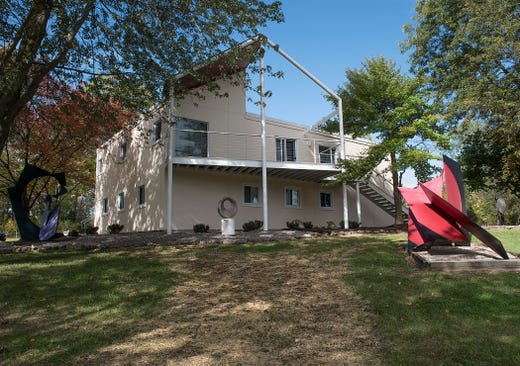
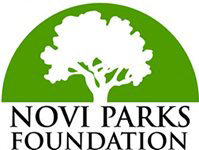
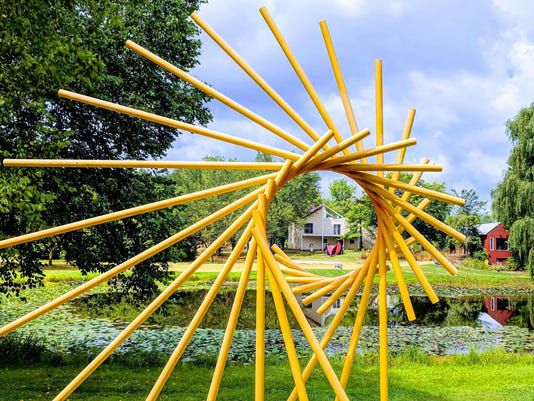
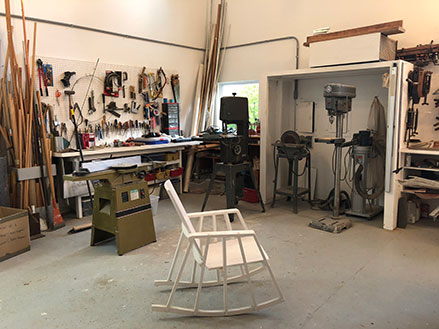
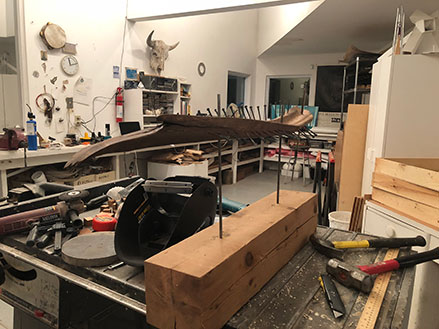
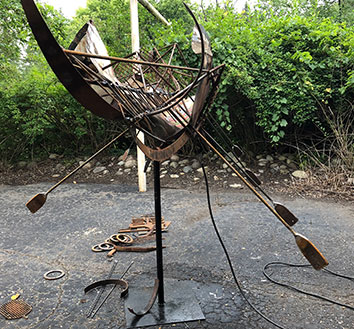
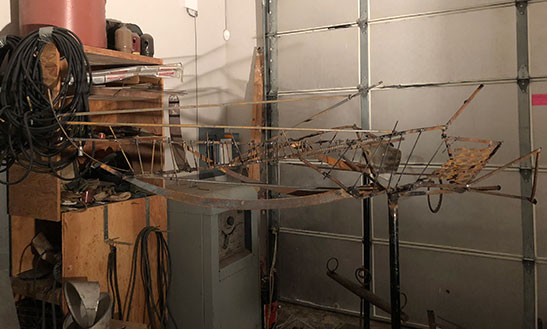
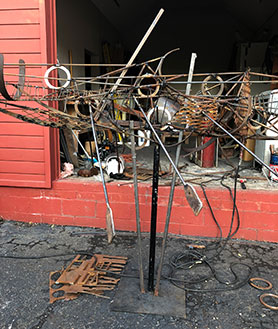
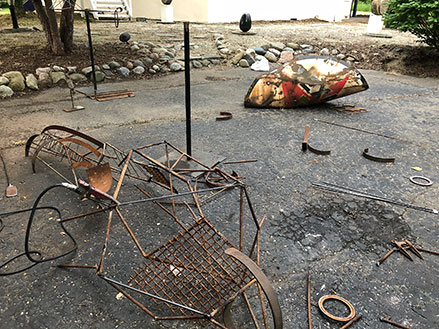


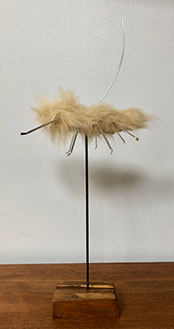
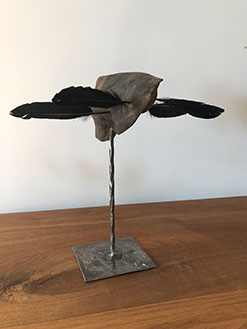
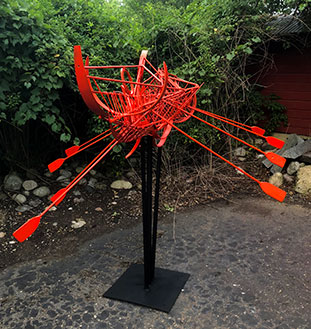
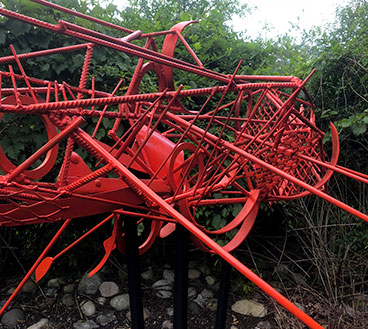
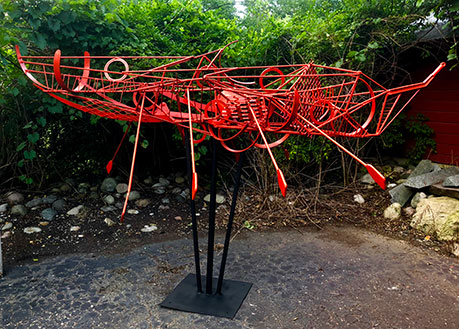
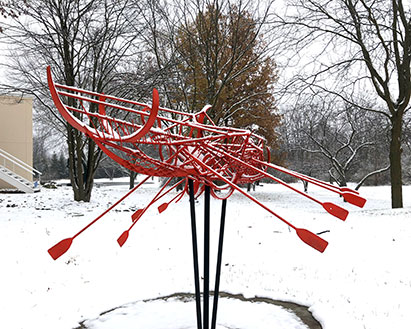
VILLA BARR ARTIST-IN-RESIDENCE PROGRAM Provide the inspiration and means for artists to create new artwork that explores “harmony with the environment – natural, social, cultural, and global.” Villa Barr is the most recent addition to the parks and recreation division of the City of Novi, Michigan. The four-acre property, previously owned by internationally recognized artist David Barr and dancer Beth Dwaihy Barr, includes a home, studio and multiple sculpture installations in a park setting. The home was designed by Chicago architect Lawrence Booth to reflect David Barr’s personal aesthetic, one that was “…germinated by constructivist principles of art, fascination with nature’s innermost structural processes, and a belief in the promises of the American democratic experiment.” The goal of the Villa Barr residency program is to provide time, space, support and inspiration in order to foster the pursuit of new ideas and new works. McCue was in an artist-in-residence at Villa Barr in August of 2018. While there here developed a body of work based on a gold artifact from the Broighter Hoard, a hoard of gold from the Iron Age of the 1st century BC found in Ireland in 1896 on farmland near Limavady. As a part of the Irish diaspora, migration is an important part of McCue’s mythology and the boat, or vessel, has grown to become an important part of his visual iconography. The Villa Barr residency provided an amazing opportunity for McCue to pursue this visual pathway and create a public work for Villa Barr Art Park. |